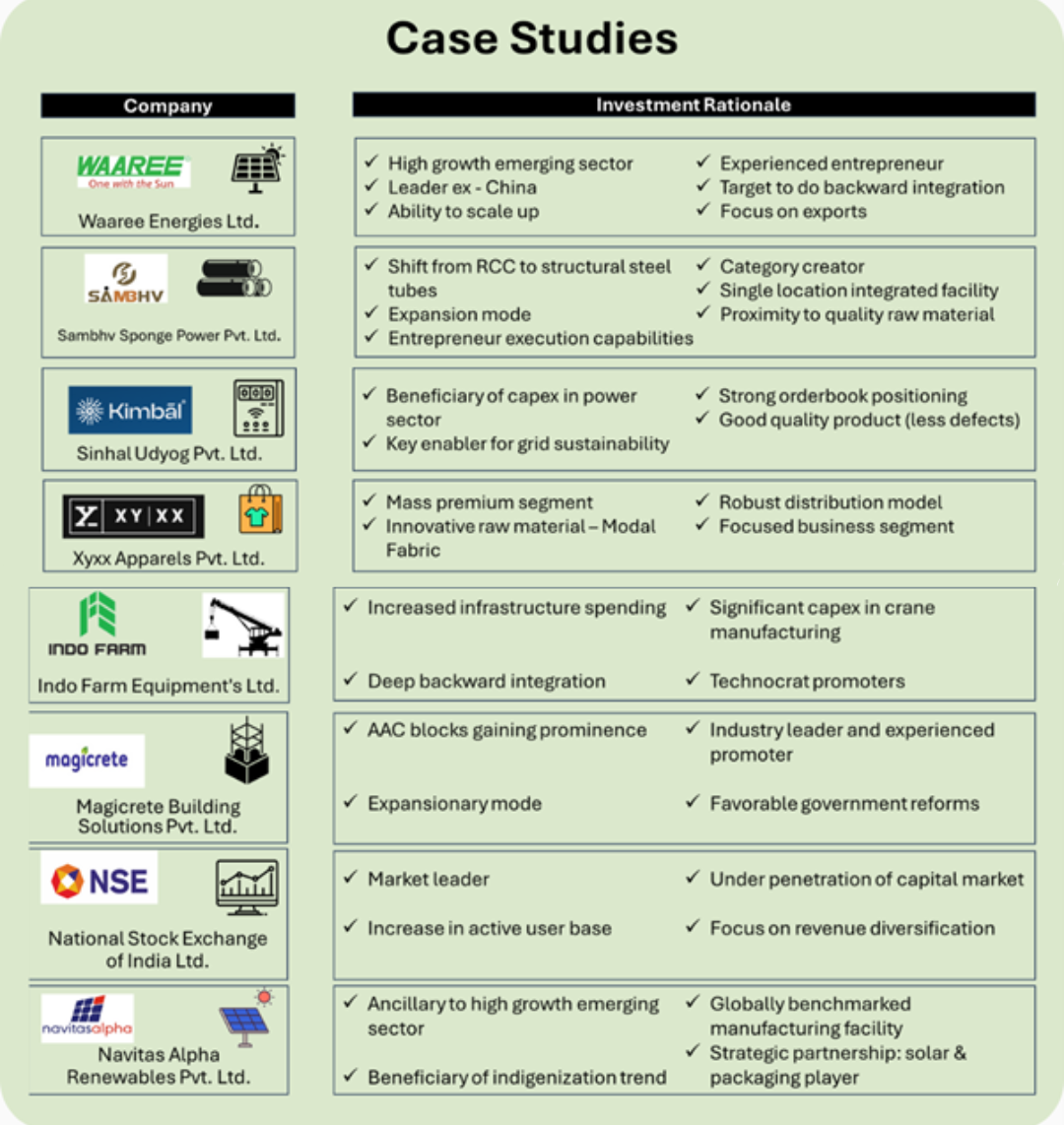India’s Private Equity Boom: Minting Gold in the Goldilocks Phase
November 13, 2024 | Deep Dives

“The rich get richer, not by hoarding their wealth, but by investing in opportunities that create more wealth.”~ A Smart Investor

India’s economy has witnessed a robust recovery from the Covid hit and we continue to grow at a favourably stout growth rate. This stout pace of growth has landed India into a unique phase, which many renowned economists globally have been naming “The Goldilocks phase.”
What is the Goldilocks phase? It refers to a phase of sustained growth with favorable economic performance during which enormous wealth creation opportunities emerge in an economy. Every developed country has witnessed the Goldilocks phase during their development years, for instance – in the US during the 1990s – the economy grew by over 50% in the Goldilocks decade, China from 2006 to early 2017 the economy more than quadrupled during this period, etc.
Many amongst the smart population seem to have identified this occasion way ahead of most economists, and their actions suggest that they have already started minting wealth from this emerging golden scenario.
In this economic backdrop, one such popular asset class that offers strong wealth-creation opportunities is the Private Equity Market. Private markets in India have been growing and this growth is being led by higher inflows from the wealthy population.
In this blog, we will be highlighting the key factors driving the Indian private equity markets and why is it being preferred over traditional asset classes –
Firstly, what are Private Equity (PE) investments?
Private Equity (PE) is a form of investment where funds are directly invested into private companies. This type of investment is usually conducted by private equity firms, venture capital firms, or angel investors.
Certain key Characteristics of Private Equity investments are:
- Private Ownership: Private equity investments are typically made in companies that are not publicly traded. These companies are either privately held or taken private through buyouts.
- Different types of PE Investments:
- Venture Capital (VC): Investments in early-stage companies with high growth potential.
- Growth Capital: Investments in more mature companies looking for capital to expand or restructure.
- Buyouts: Acquiring a significant portion or the entirety of a company. Leveraged buyouts (LBOs) are common, where the acquisition is financed largely through debt. - Investment Horizon: PE investments usually have a long-term horizon. The goal is to improve the company's value and eventually exit through a sale, IPO, or another form of exit strategy.
- Active Management: Private equity firms often take a hands-on approach, involving themselves in the strategic direction and operations of the companies they invest in to enhance value. The fund managers play a crucial role in this part.
How Private Equity Works?
- Fundraising: PE firms raise capital from institutional investors, high-net-worth individuals, and other sources to create a private equity fund. These investors are usually “Limited Partners” in the PE Fund.
- Investment: The fund managers identify and invest in companies with potential for growth or improvement. This involves detailed due diligence to assess the viability and potential of the target companies.
- Management and Growth: The PE firm works closely with the management of the portfolio companies to implement strategic improvements, operational efficiencies, and growth initiatives.
- Exit: After several years, the PE firm exits the investment, ideally at a higher valuation, providing returns to its investors.

Benefits and Risks
Benefits:
- Potential for high returns: PE investments can yield substantial returns if the target companies perform well.
- Value creation: PE firms often improve the operations and profitability of the companies they invest in.
- Diversification: Provides an alternative investment vehicle outside of public markets.
Risks:
- Illiquidity: Investments are typically locked in for a long period of time.
- High risk: The success of investments can be highly variable, and there's a chance of losing the invested capital.
- Complexity: Requires significant due diligence and active management.
Why exit is so important & Why do need a fund manager for exit?
- Illiquidity: Due to the illiquid nature of these investments, it is often difficult to convert equity stakes into cash in such investments. The fund managers play an important role in curating a favorable exit strategy that can generate maximum returns for the Limited Partners.
- Due Diligence: These investments require significant due diligence and regulatory procedures before any exit can be made. This is why planning an appropriate exit strategy that duly meets the investor's expectations is important.

What’s Driving PE in India?

Some Key factors driving the growth of PE market in India are:
- Valuation concerns in listed equity markets – The Indian listed markets have seen a stellar rally post the Covid pandemic. The broader market has almost tripled from COVID-19 lows and most of the listed stocks are trading at their upper range of historic valuation multiples. In such a situation, it is difficult to find new wealth-creation opportunities in the broader listed space. In such a scenario, the private markets present more lucrative opportunities for generating high returns.
- Visibility of Exit – Exit is prima facie very important while investing in the PE space, as it is a challenging task. Unlike the listed space where a secondary sale can be made with just a click of a button, PE space requires considerable effort and time to curate a lucrative exit. As explained earlier, there are 4 possible modes of exit – Buyback, Strategic Sale, Secondary sale (Sponsor to Sponsor sale), and Public Issue (IPO/OFS). The growing IPO trend coupled with rising buyouts has led to better visibility of exit thus encouraging more investors to scout opportunities in the unlisted space.

- Growing AIF investments – the AIF commitments have quadrupled in the last 5 years with maximum capital flowing into AIF Category II funds. The AIF category II funds focus on PE deals and this growing trend indicates growing investor interest in this asset class.
- Growing HNI and UHNI Population – The High Net-worth Individuals population (net worth of $1 million and above) has tripled in the last 5 years. Thereby people are scouting for alternate assets to park their excess income and private equity is emerging as a lucrative option amongst UHNI/HNI.

- China+1 Tailwind – With the focus of global players on diversifying their manufacturing base from China, India stands out to be a major beneficiary. Many global players have set up and many others are looking to set up their manufacturing base in India. The bulk of India’s manufacturing lies far from public eyes – in the private space. There are various players like Sambhav Steel, Waaree Energies, etc. which are sector leaders and innovators in their sector but since these entities are not listed it is not possible for every investor to own shares of these companies. In such a situation, PE investment firms facilitate access to such hidden opportunities which have the potential to create immense wealth in the medium/long term.
- Growing PE Ecosystem – The growing participation of investors in the PE space coupled with an increasing number of PE firms has led to the creation of a better PE ecosystem. Although this space remains highly fragmented, efforts are being made by many modern players to centralize/integrate the various aspects of this segment. The recent emergence of applications like Stockify, unlistedkart, Precize, etc. is further promoting investor education in this segment.
How can Niveshaay help you in planning your PE investments?
Niveshaay offers end-to-end fund management solutions in the PE space – right from deal origination to curating lucrative exits for our investors. We help our clients in their wealth creation journey by structuring the right mix of listed and unlisted opportunities.

Our key strength lies in our approach in the unlisted markets. Our approach allows us to identify strong entrepreneurs in industries that are witnessing healthy tailwinds.

Over the years, we have successfully structured multiple deals with industry leaders such as Waaree Energies Ltd, Sambhav Steel Pipes Ltd, Sinhal Udyog Pvt Ltd (Kimbal), XYXX Apparels Pvt Ltd, Magicrete etc.
We have recently introduced our two AIFs (Alternative Investment Funds)
- Niveshaay Hedgehogs Fund (Category III)
This fund primarily focuses on listed opportunities, with a smaller allocation dedicated to unlisted investments. The Hedgehogs Fund offers a balanced approach, combining the stability of listed assets with the growth potential of niche unlisted investments. - Niveshaay Sambhav Fund (Category II)
The Sambhav Fund is majorly focused on unlisted opportunities, where we back exceptional founders and visionary entrepreneurs on their growth journey.

In conclusion, India's private equity market is booming, driven by growing AIF investments, an increasing population of HNWIs and UHNWIs, and attractive opportunities beyond the overheated public markets. The improved visibility of exits and rising investments in traditional sectors further enhance its appeal. This unique phase positions private equity as a significant avenue for wealth creation in India's growing economy.
Hope you enjoyed this blog! Get in touch with our team for more information on our unlisted space opportunities. Contact details are provided in the Contact Us section on our website – www.niveshaay.com.
Happy Investing!
Disclaimers and Disclosures
SEBI Registration No. :INH000017338, IN/AIF3/24-25/1571, IN/AIF2/24-25/1607 | BASL Membership ID: 6276
Investment in Securities Market are subject to market risks. Read all related documents carefully before investing. The securities quoted are for illustration only and are not recommendatory. Registration granted by SEBI, membership of a SEBI recognized supervisory body (if any) and certification from NISM in no way guarantee performance of the intermediary or provide any assurance of returns to investors.


 Follow
Follow